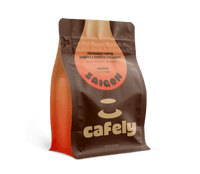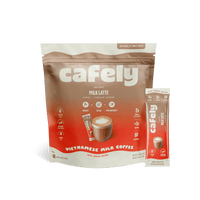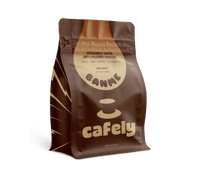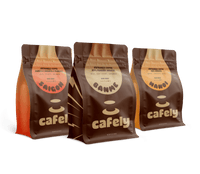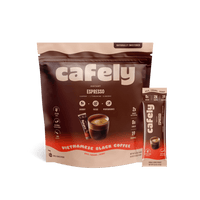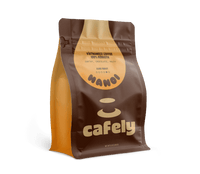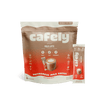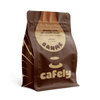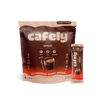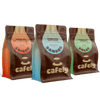Are you buying coffee beans in bulk and finding the flavors and aroma of your brews fading? Just how long do coffee beans stay fresh?
Though the shelf-life of coffee beans depends on the type and quality, they generally peak in flavor in the first two weeks after they are roasted.
We’ll explore the factors that affect beans’ freshness, how you can tell your beans are stale, ways you can ensure you’ll have a fresh cup of coffee, and more!
>> Pick up some delicious single-origin fresh-roasted coffee beans here!
How Long Are Coffee Beans Good For?
Like all perishable food items, coffee beans have a lifespan during which they peak in quality and flavor. When you purchase a bag of coffee beans, you'll find the bag stamped with a date. This isn't the expiration date but the estimated time period for which the beans have the best aroma and flavor.
Two main factors affect the shelf life of coffee beans: their state (green, roasted, or ground) and their storage conditions.
Green Coffee Beans

Green, unroasted coffee beans have the longest shelf life. If they are stored in a cool, dry environment with little exposure to light and air, these beans can stay fresh and flavorful for up to eighteen weeks [1].
Roasted Coffee Beans

Once you roast coffee beans, their shelf life takes a major downturn. Roasted coffee beans peak in flavor within the first couple of weeks.
If properly stored, roasted coffee beans can stay relatively fresh for up to six months after the first two weeks. Storing them in an airtight, opaque container in a cool, dark environment will help them maintain their flavor and vibrancy.
Ground Coffee

Ground coffee has a much shorter shelf-life than any other form of coffee. Because their surface area is increased, the grounds are exposed to much more air and moisture than when they were full beans.
Unopened bags of ground coffee will retain great flavor and aroma for around three to five months. Coffee drinkers should use opened packages of coffee grounds within 7 days to enjoy the optimal flavor.
Factors That Influence Coffee Bean Freshness
There are 3 main factors that impact the freshness of the coffee you brew. Managing these factors effectively ensures you can brew the best cup of coffee possible.
1. Packaging & Sealing
How your coffee beans are stored, green, roasted, or ground, can impact the shelf-life of the beans.
You’ll want as little exposure to air, light, and moisture as possible in any state the beans are in.
Fluctuating temperatures, humidity, and bright light can deteriorate the beans’ volatile compounds and oils, leading to weakened flavor and aroma.
2. Storage Conditions
We’ve discussed the importance of protecting coffee from the elements, such as air, light, moisture, and fluctuating temperatures. Any of these factors can cause beans to lose flavor faster.
3. Roast Levels
Beans are roasted at different temperatures and lengths of time for different flavors, but the levels at which they are roasted can also affect their shelf life. Lighter roasts hold onto the bean's essential gases for a longer period of time, keeping them fresher longer [2].
Medium roasts, like the DaNang blend, release gases faster, and Dark roasts, like the Saigon OG Blend, release CO2 and other gases at the fastest rate. The degassing rate of these different roast levels may mean darker roasts become stale sooner than lighter roasts.
Signs of Stale Coffee Beans
Here are several clues that you should look out for to tell if your beans have gone stale:
Appearance
Freshly roasted coffee beans should have a shiny, oily appearance, with colors that reflect their roast levels. As the beans get older, their sheen and color will slowly fade, indicating they’re past their peak.
Aroma
There’s nothing like the strong smell of fresh coffee. As the beans age, their smell becomes muted and flat and can even become rancid.
Texture
We know that coffee beans should be visually oily and shiny, and the same goes for how they should feel. As they get stale, they’ll become more brittle and dry as they lose oils.
Taste
The most obvious sign of stale coffee beans is their taste. When ground and brewed, your beverage will be weak, dull, and even bitter.
Getting the Most Out of Your Coffee: Buying Tips

There are several ways to ensure your coffee beans and grinds stay fresh. Let’s take a look at some of the best practices you can use:
Buy in Small Quantities
Yes, it is convenient and potentially cheaper to grab a huge bag of coffee from a wholesaler, but you should resist the temptation. Buying smaller portions of coffee will ensure you have the freshest cup of joe possible.
Check the Roast Date
Pay close attention to the roast date instead of the “best buy” or “expiration” date. This date is a better indicator of the bean’s freshness. You’ll want to use the beans within two to four weeks of the roast date.
Grind Right Before Brewing
As we said previously, coffee grinds have the shortest shelf life of any form of coffee. Buying a grinder and grinding your own fresh beans at home is a great way to keep your coffee strong and flavorful.
Buy From Reputable Roasters
We’ve stressed the importance of checking the roasting dates on coffee bags. You’ll want to buy from a reputable vendor that stamps accurate roasting dates on their products — especially if you’re wondering where to buy coffee beans that are both fresh and high quality.
→ Shop Cafely Whole Bean Coffee
What to Do With Stale Coffee Beans
Even if your beans have started to go stale, there are plenty of unique ways you can use spent or stale coffee around the house.
1. Skin Care
Ground coffee is an incredible exfoliator. Even stale coffee will do wonders for the skin.
To use it, simply bring some coarsely ground coffee into the shower with you and scrub your face and body. Let it sit for a minute or two before rinsing off.
2. Gardening & Composting
Coffee grinds are rich in nutrients like nitrogen and potassium, which are essential to some plants [3]. Add a couple of scoops of coffee to your soil and mix it well before planting, or sprinkle grinds on top of pre-potted plants.
Grinds are great for composting, too. The nutrients in the grinds help balance your compost, speeding up the decomposition and improving the end result [4].
FAQs: Coffee Storage

Are you still curious about coffee beans? Let’s take a look at the most frequently asked questions and their answers.
1. Can I store coffee beans in the freezer?
Yes, you can store coffee beans in the freezer, but only under optimal conditions. The best storage method if you’re planning on freezing is to have your beans vacuum sealed in an opaque container.
Avoid taking coffee in and out of the freezer; once it goes in, leave it there until you're ready to drink it. It's also wise to avoid placing opened packages of coffee in the freezer (increased risk of freezer burn).
Related: Does Coffee Go Bad in the Fridge?
2. How can I tell if my coffee beans are still good?
The best way to tell if your beans are good is to first check how they look. At their peak, they should be shiny and oily, they should smell strong and fresh, and they should feel springy and light. Using high-quality, fresh beans is key to making a good coffee every time.
Related: How Long can Coffee Sit it Out?
3. Does the type of bean affect the shelf-life?
Though specific studies have not compared the two beans, the general consensus is that Robusta beans have a longer shelf life than Arabica beans.
4. What is the best container to store coffee beans?
Find an opaque and airtight container if you want your coffee beans to last. You’ll want as little exposure to light, air, and moisture for long-lasting beans.
5. How often should I replace my coffee beans?
In general, you should replace your coffee beans every two to four weeks. Your best bet, though, is to buy smaller amounts of beans so you can brew them in the two week timeframe.
6. Are there any tools to help keep coffee beans fresh?
Yes, there are many items on the market that will help you keep your coffee beans fresh. For example, vacuum-sealed canisters, CO2-releasing storage containers, and one-way valve bags are great products that help keep your beans out of the elements.
7. Is it okay to buy pre-ground coffee?
Yes, you can buy pre-ground coffee. However, you’ll want to use your bag of coffee grinds within a week of opening.
8. What does 'off-gassing' mean in the context of coffee beans?
Off-gassing is the process that coffee beans go to as they naturally release carbon dioxide over time. After roasting coffee beans, they’ll have a build-up of CO2. As they mature, the beans will release some of the gas, giving you a more complex, stronger flavor.
9. Can light and dark roasted beans be stored the same way?
Yes, in general, dark and light roasted beans should be stored the same way. However, lighter roasts have a longer shelf-life of up to four weeks, while dark roasts usually last one to two weeks before going stale.
10. What are the best conditions for storing coffee beans?
As we’ve mentioned previously, you should store coffee beans in an airtight container and place them in a dry, cool environment.
References
- Kreuml MT, Majchrzak D, Ploederl B, Koenig J. Changes in sensory quality characteristics of coffee during storage. Food Sci Nutr. 2013 Jul;1(4):267-72. doi: 10.1002/fsn3.35. Epub 2013 May 4. PMID: 24804030; PMCID: PMC3951592.
- Samo Smrke, Marco Wellinger, Tomonori Suzuki, Franz Balsiger, Sebastian E. W. Opitz, and Chahan Yeretzian Journal of Agricultural and Food Chemistry 2018 66 (21), 5293-5300 DOI: 10.1021/acs.jafc.7b03310.
- Nuhu, A. A. (2014). Bioactive micronutrients in coffee: Recent analytical approaches for characterization and quantification. ISRN Nutrition, 2014, 1–13.
- Adi, A., & Noor, Z. (2009). Waste recycling: Utilization of coffee grounds and kitchen waste in vermicomposting. Bioresource Technology, 100(2), 1027–1030.
